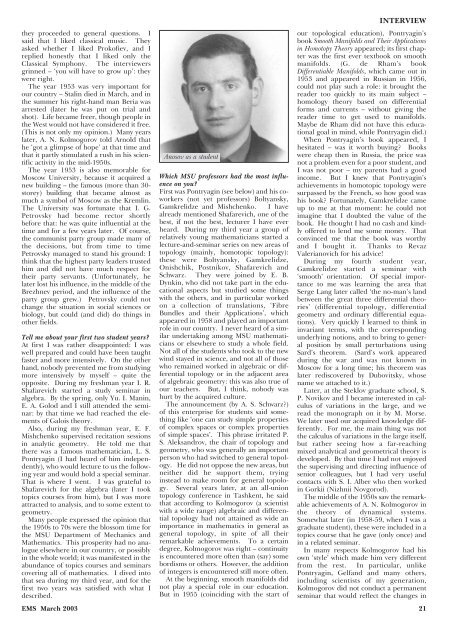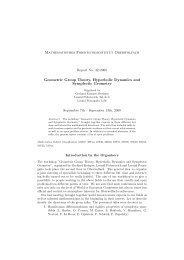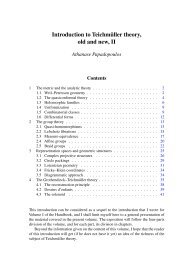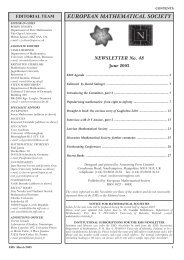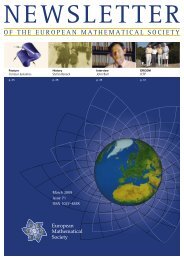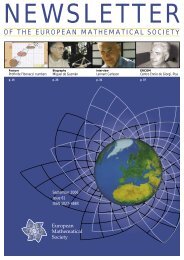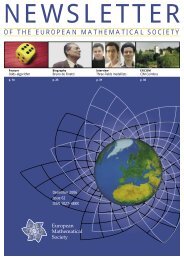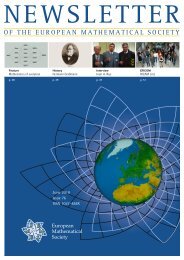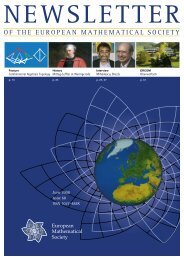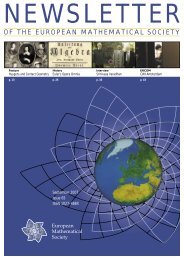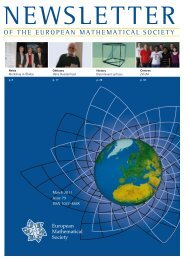March - European Mathematical Society Publishing House
March - European Mathematical Society Publishing House
March - European Mathematical Society Publishing House
You also want an ePaper? Increase the reach of your titles
YUMPU automatically turns print PDFs into web optimized ePapers that Google loves.
they proceeded to general questions. I<br />
said that I liked classical music. They<br />
asked whether I liked Prokofiev, and I<br />
replied honestly that I liked only the<br />
Classical Symphony. The interviewers<br />
grinned – ‘you will have to grow up’: they<br />
were right.<br />
The year 1953 was very important for<br />
our country – Stalin died in <strong>March</strong>, and in<br />
the summer his right-hand man Beria was<br />
arrested (later he was put on trial and<br />
shot). Life became freer, though people in<br />
the West would not have considered it free.<br />
(This is not only my opinion.) Many years<br />
later, A. N. Kolmogorov told Arnold that<br />
he ‘got a glimpse of hope’ at that time and<br />
that it partly stimulated a rush in his scientific<br />
activity in the mid-1950s.<br />
The year 1953 is also memorable for<br />
Moscow University, because it acquired a<br />
new building – the famous (more than 30storey)<br />
building that became almost as<br />
much a symbol of Moscow as the Kremlin.<br />
The University was fortunate that I. G.<br />
Petrovsky had become rector shortly<br />
before that: he was quite influential at the<br />
time and for a few years later. Of course,<br />
the communist party group made many of<br />
the decisions, but from time to time<br />
Petrovsky managed to stand his ground: I<br />
think that the highest party leaders trusted<br />
him and did not have much respect for<br />
their party servants. (Unfortunately, he<br />
later lost his influence, in the middle of the<br />
Brezhnev period, and the influence of the<br />
party group grew.) Petrovsky could not<br />
change the situation in social sciences or<br />
biology, but could (and did) do things in<br />
other fields.<br />
Tell me about your first two student years?<br />
At first I was rather disappointed: I was<br />
well prepared and could have been taught<br />
faster and more intensively. On the other<br />
hand, nobody prevented me from studying<br />
more intensively by myself – quite the<br />
opposite. During my freshman year I. R.<br />
Shafarevich started a study seminar in<br />
algebra. By the spring, only Yu. I. Manin,<br />
E. A. Golod and I still attended the seminar:<br />
by that time we had reached the elements<br />
of Galois theory.<br />
Also, during my freshman year, E. F.<br />
Mishchenko supervised recitation sessions<br />
in analytic geometry. He told me that<br />
there was a famous mathematician, L. S.<br />
Pontryagin (I had heard of him independently),<br />
who would lecture to us the following<br />
year and would hold a special seminar.<br />
That is where I went. I was grateful to<br />
Shafarevich for the algebra (later I took<br />
topics courses from him), but I was more<br />
attracted to analysis, and to some extent to<br />
geometry.<br />
Many people expressed the opinion that<br />
the 1950s to 70s were the blossom time for<br />
the MSU Department of Mechanics and<br />
Mathematics. This prosperity had no analogue<br />
elsewhere in our country, or possibly<br />
in the whole world; it was manifested in the<br />
abundance of topics courses and seminars<br />
covering all of mathematics. I dived into<br />
that sea during my third year, and for the<br />
first two years was satisfied with what I<br />
described.<br />
Anosov as a student<br />
Which MSU professors had the most influence<br />
on you?<br />
First was Pontryagin (see below) and his coworkers<br />
(not yet professors) Boltyansky,<br />
Gamkrelidze and Mishchenko. I have<br />
already mentioned Shafarevich, one of the<br />
best, if not the best, lecturer I have ever<br />
heard. During my third year a group of<br />
relatively young mathematicians started a<br />
lecture-and-seminar series on new areas of<br />
topology (mainly, homotopic topology):<br />
these were Boltyansky, Gamkrelidze,<br />
Onishchik, Postnikov, Shafarevich and<br />
Schwarz. They were joined by E. B.<br />
Dynkin, who did not take part in the educational<br />
aspects but studied some things<br />
with the others, and in particular worked<br />
on a collection of translations, ‘Fibre<br />
Bundles and their Applications’, which<br />
appeared in 1958 and played an important<br />
role in our country. I never heard of a similar<br />
undertaking among MSU mathematicians<br />
or elsewhere to study a whole field.<br />
Not all of the students who took to the new<br />
wind stayed in science, and not all of those<br />
who remained worked in algebraic or differential<br />
topology or in the adjacent area<br />
of algebraic geometry: this was also true of<br />
our teachers. But, I think, nobody was<br />
hurt by the acquired culture.<br />
The announcement (by A. S. Schwarz?)<br />
of this enterprise for students said something<br />
like ‘one can study simple properties<br />
of complex spaces or complex properties<br />
of simple spaces’. This phrase irritated P.<br />
S. Aleksandrov, the chair of topology and<br />
geometry, who was generally an important<br />
person who had switched to general topology.<br />
He did not oppose the new areas, but<br />
neither did he support them, trying<br />
instead to make room for general topology.<br />
Several years later, at an all-union<br />
topology conference in Tashkent, he said<br />
that according to Kolmogorov (a scientist<br />
with a wide range) algebraic and differential<br />
topology had not attained as wide an<br />
importance in mathematics in general as<br />
general topology, in spite of all their<br />
remarkable achievements. To a certain<br />
degree, Kolmogorov was right – continuity<br />
is encountered more often than (say) some<br />
bordisms or others. However, the addition<br />
of integers is encountered still more often.<br />
At the beginning, smooth manifolds did<br />
not play a special role in our education.<br />
But in 1955 (coinciding with the start of<br />
INTERVIEW<br />
our topological education), Pontryagin’s<br />
book Smooth Manifolds and Their Applications<br />
in Homotopy Theory appeared; its first chapter<br />
was the first ever textbook on smooth<br />
manifolds. (G. de Rham’s book<br />
Differentiable Manifolds, which came out in<br />
1953 and appeared in Russian in 1956,<br />
could not play such a role: it brought the<br />
reader too quickly to its main subject –<br />
homology theory based on differential<br />
forms and currents – without giving the<br />
reader time to get used to manifolds.<br />
Maybe de Rham did not have this educational<br />
goal in mind, while Pontryagin did.)<br />
When Pontryagin’s book appeared, I<br />
hesitated – was it worth buying? Books<br />
were cheap then in Russia, the price was<br />
not a problem even for a poor student, and<br />
I was not poor – my parents had a good<br />
income. But I knew that Pontryagin’s<br />
achievements in homotopic topology were<br />
surpassed by the French, so how good was<br />
his book? Fortunately, Gamkrelidze came<br />
up to me at that moment: he could not<br />
imagine that I doubted the value of the<br />
book. He thought I had no cash and kindly<br />
offered to lend me some money. That<br />
convinced me that the book was worthy<br />
and I bought it. Thanks to Revaz<br />
Valerianovich for his advice!<br />
During my fourth student year,<br />
Gamkrelidze started a seminar with<br />
‘smooth’ orientation. Of special importance<br />
to me was learning the area that<br />
Serge Lang later called ‘the no-man’s land<br />
between the great three differential theories’<br />
(differential topology, differential<br />
geometry and ordinary differential equations).<br />
Very quickly I learned to think in<br />
invariant terms, with the corresponding<br />
underlying notions, and to bring to general<br />
position by small perturbations using<br />
Sard’s theorem. (Sard’s work appeared<br />
during the war and was not known in<br />
Moscow for a long time; his theorem was<br />
later rediscovered by Dubovitsky, whose<br />
name we attached to it.)<br />
Later, at the Steklov graduate school, S.<br />
P. Novikov and I became interested in calculus<br />
of variations in the large, and we<br />
read the monograph on it by M. Morse.<br />
We later used our acquired knowledge differently.<br />
For me, the main thing was not<br />
the calculus of variations in the large itself,<br />
but rather seeing how a far-reaching<br />
mixed analytical and geometrical theory is<br />
developed. By that time I had not enjoyed<br />
the supervising and directing influence of<br />
senior colleagues, but I had very useful<br />
contacts with S. I. Alber who then worked<br />
in Gorkii (Nizhnii Novgorod).<br />
The middle of the 1950s saw the remarkable<br />
achievements of A. N. Kolmogorov in<br />
the theory of dynamical systems.<br />
Somewhat later (in 1958-59, when I was a<br />
graduate student), these were included in a<br />
topics course that he gave (only once) and<br />
in a related seminar.<br />
In many respects Kolmogorov had his<br />
own ‘style’ which made him very different<br />
from the rest. In particular, unlike<br />
Pontryagin, Gelfand and many others,<br />
including scientists of my generation,<br />
Kolmogorov did not conduct a permanent<br />
seminar that would reflect the changes in<br />
EMS <strong>March</strong> 2003 21


